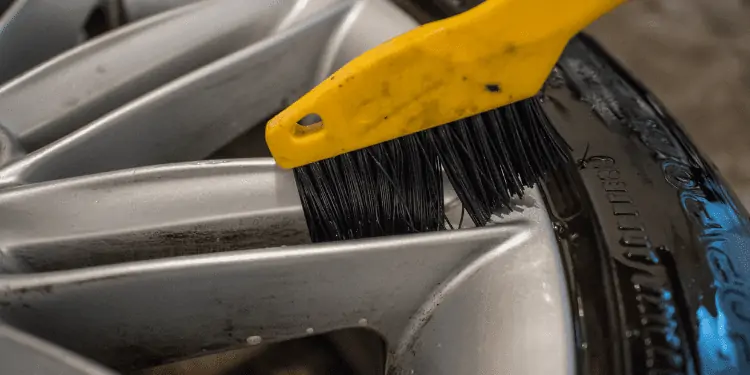So you’ve got your car looking its best and cleaned thoroughly, but you can’t eliminate the brown stains on your tire’s sidewalls.
Here, we’ll discuss why tires go brown and what you can do, if anything, to get them back to pristine black again. The first thing to consider is that tires go brown naturally.
As tires have become more advanced throughout the years, there has been a need to last longer and perform better.
Because of this, chemicals are added to the tires to keep them pliable in all weather conditions.
The major reason for the brown discoloration of tire sidewalls is an antiozonant that is added to the rubber when manufactured. It prevents tires from drying out too quickly and cracking as a result of oxidation. Blooming is the common name for tires aging and turning brown.
Tire Advances – A Little History
Years ago, tires were never expected to last more than 10 to 15,000 miles. But nowadays, as long as driving patterns are conservative, tires can last 30,000 miles plus, depending on the rubber compound.
Rubber tires were introduced in the early 1900s, but it wasn’t until the 1920s that synthetic rubber turned tire production around and made great strides in road handling and tire longevity.
Radial tires became popular in the 1940s, which greatly increased the speed cars could travel and offered better stability on the road. This was able to be achieved as the ply and cords were vertical.
Additives were starting to be added to synthetic rubber at around this stage. To make tires last longer. An organic compound has been added to them in recent years called antiozonant.
Antiozonant and Tires
This element is used in tires throughout manufacturing in many rubber products exposed to heat and moisture.
It works by slowing down the aging process of rubber and helps keep it supple, preventing it from drying out and oxidizing. These are all important factors in keeping tires on the road for longer. We would still be driving cars at lower speeds without antiozonant because the heat build-up would make the tires perish very quickly.
If tires from the 1940s and before were driven at today’s speeds, we’d have to change them a lot more frequently.
The brown hue on your tire wall is the antiozonant being pushed onto the sidewall from inside the tire.
Tire blooming
The antiozonant that has been depleted outside the tire wall gets replenished from within the tire.
If this process didn’t occur, the tie would eventually perish and dry out sooner than it is designed to do.
A consequence of this is the brown coloration you see on the tire wall. Although it may be unsightly, it is normal and serves a certain purpose of keeping your tires in good condition, therefore, increasing the time between periods of replacement.
It is not the antiozonant itself that causes the brown coloration. It is the interaction with the air. It’s similar to metal exposed to water and the air turning to rust.
Mold is also released when the factory manufactures the tire to amplify the situation.
These lubricant molding chemicals provide a nonstick surface to the tire mold. And when the tire is released from the mold, the chemicals are often retained on the tire.
Many people point to the mold release of the manufacturing process has been the primary cause of tire blooming, but this isn’t the case.
Even after removing the residue, you will still find that tire blooming occurs as the anti-ozonant pushes its way onto the tire wall.
So, it stands to reason that there is very little you can do to prevent brown discoloration of your sidewalls.
However, regular cleaning can keep the appearance at bay and keep your tires looking black like when they came out of the factory.
Silicone and Tire Blooming
Many people have accused silicone of being the culprit of brown staining. Now, silicone is generally used in the production of tires, especially in winter tires, as it can provide more grip on the tread blocks.
However, they play no part in causing your tires to go brown.
Brake Replacement and Brown Tires
If you’ve recently had your brakes replaced, you may, or the car shop may have dislodged brown dust from your brakes, which have accumulated on your tires.

Most decent car shops will clean your tires after replacing your brakes, but not all. So if the brown hue you see on your tires is only after having your brakes, pads, or rotors changed, clean down your tires, and you’ll probably find the coloration disappears.
Many visitors read this article next: Minor Dry Rotted Tires [GUIDE]
Cleaning Tires To Prevent Brown Tires
As tire blooming is a continual process, cleaning and dressing the tires regularly is important to remove the excess. There is no point in simply painting the tires black or dressing them this way because the blooming will still come through rapidly. Therefore, cleaning those tires to remove all the blooming before painting them black is important.
Cleaning tires to remove brown blooming
- Remove the dirt and debris from the tires and rims using a firm but not wire brush. Rinse off with water using a clean bucket of water or a hose or pressure washer.
- Apply the cleaner and let it for a few minutes, or as directed by the information on the side of the bottle.

- Meticulously clean the tire sidewalls areas that have become brown with a tire brush.
- Gently work your way around the rest of the tire. Most tire cleaners can be left on the tire for a few minutes to help remove more stubborn brown hues.
- Rinse away with clean water and inspect the tire to see if brown areas remain. If so, repeat the process. Tires that haven’t been cleaned for a while may need a couple of cycles to eliminate all the anti ozonants.
- Dry off with a clean rag, or let the tire dry naturally.
Tire Dressing to Prevent Browning
Water Based Tire Dressing
Using water-based tire dressing has many advantages over the older solvent-based dressing that was more popular twenty years ago. As no petroleum chemical elements are added to water-based dressing, the tire’s life isn’t reduced by their use.

Additives are included, but these are generally natural oils that lubricate the sidewall, prevent premature tire aging, and help slow blooming.
Tire Wax
Tire wax requires more work, but the results are generally better.
As with water-based dressing, tire wax will lubricate your tire sidewalls.
Think of it as cleaning and polishing your walking boots and then adding a protective wax to keep them dry afterward.
Before applying the wax, it is important to clean them thoroughly and remove any oil or grease your tires may have picked up when driving.
Although not preventing blooming, Tire wax will keep it at bay for longer.
Tire Sealants
Tire Sealants are rarely used because they are more expensive than tire wax and tire dressing.
But if you are determined to keep blooming away from your tires for as long as possible, this is the way. Once again, it would be best if you cleaned the tire thoroughly. But once you put the tire sealant on, it encases the tire in a protective wrapping that will stop the hue from coming through more quickly.
Are Brown Tires Dangerous?
Not at all. Brown tires occur naturally from the antiozonants reacting with water and oxygen. They may look unsightly but are perfectly safe to drive with.





![Minor Dry Rotted Tires [GUIDE] Tire-veins-dry-rot](https://carzaza.com/wp-content/uploads/2023/12/Tire-veins-dry-rot-300x150.png)







